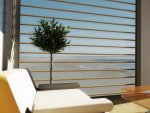Hi Joe,
Not sure if I am reading the images properly, but there does not appear to be a drop-down deck:


The side merely flips up, exposing a huge set of sliding-doors/sliding-screens, and this flip-up side becomes a hard awning. Whereas what I've been imagining is the exact opposite, with the side flipping
down, not up; and a merely fabric awning supported by a "pergola" frame providing shade. With the fabric of course covered by thin-film flexible solar panels. Even still, I very much like the huge sliding-doors/sliding-screens part of the design, and the aspiration to visually and physically connect the camper interior to the outside. So many thanks for posting this, and yes, very much
"kinda like this"....:victory:
Gosh, you Australians sure are terrific when it comes to motorhome design experimentation!!
*****************************************
1. The Unsuitablity of the Unimog Chassis
*****************************************
Now
Joe, I fully realize that you posted this image to suggest how other people have also be thinking that it would be nice to have a well-lit motorhome interior, one with sliding doors that lead directly outside. You posted this image because of the sliding doors, not because it's a Unimog. But I would like to use this vehicle as an opportunity to slam hard on the Unimog as a possible chassis for a 12 m motorhome, just in case anyone might get the wrong "message" from the image that you posted.
I really liked the comments in the ExPo thread that discusses this vehicle, especially the concerns expressed about the unsuitability of a Unimog as a base-chassis for a motorhome that won't do that much off-road driving:
"But a Unimog is an odd choice of platform for that kind of thing, I'd have thought. Unimogs have low power to weight ratio..... cramped cabin, poor road performance, poor economy etc etc. As he can't use the superb off-road abilities of a Unimog (the payback for all those disadvantages)...." See http://www.expeditionportal.com/forum/threads/32893-Aussie-unimog?p=479143#post479143 . Given that the TerraLiner has been defined as merely a "bad road capable" vehicle right from the beginning, the Unimog always struck me as totally inappropriate.
There's also the size factor. If memory serves, a while back Mercedes made a Unimog with 3 axles, but today the Unimog has just has two -- see
http://www2.mercedes-benz.co.uk/con...MEDIA.tmp/U4023-U5023TechnicalInformation.pdf . The current Unimog is a relatively small vehicle, only 6 m long, so when Bran Ferren used a Unimog in the Kiravan, he had to modify the chassis both by lengthening it and adding a third axle. In the above vehicle the chassis lengthening resulted in a vehicle that's not very good in sand, because it's so long, and yet still has only two axles -- see
http://www.expeditionportal.com/forum/threads/32893-Aussie-unimog?p=478633#post478633 .
*****************************************
2. The Flexing Camper Body of Larry Perkins' Unimog Conversion
*****************************************
Iain, I also could not help but notice in the article describing Larry Perkins' Unimog conversion, that there is a very ominous sentence which states that not only the frame twists, but so too,
the camper body (!!!:Wow1: !!!) -- see
http://www.drive.com.au/motor-news/perkins-swaps-racetrack-for-outback-20110525-1f4vs.html :
By using flat sheet metal, Perkins was able to use industrial-strength adhesive to fix the external panels to the superstructure, reducing weight and providing some degree of flex in off-road situations.
In other words, even a total Petrol-Head like Larry Perkins, with his own massive workshop, could not adapt the Unimog flexible chassis sufficiently to accommodate a completely rigid, fully integrated camper body. That's no doubt why the interior of Perkin's conversion so comparatively spartan and nondescript, with furniture perhaps designed so that it merely secures to the floor, and not to the camper body side-walls, which will flex:


It should go without saying that this is absolutely
not a design precedent for the TerraLiner!
The exterior of the Perkins conversion is OK, but it's not a Newell, if only because Perkins simply stuck a
Kenworth K104 Aerodyne truck cab on the front. The change in roof height between cab and camper, and the skylights behind the cab, are interesting design details; they remind me of the 1950's-era Flxible Vista Liner and Greyhound Scenicruiser, and of course the "Tatra Around the World" 815 GTC, discussed at length earlier in the thread -- see https://en.wikipedia.org/wiki/Flxible ,
http://flxibleowners.org/breeds-of-flxibles/ ,
https://en.wikipedia.org/wiki/PD-4501_Scenicruiser , and see post #288 and following, at
http://www.expeditionportal.com/for...igid-Torsion-Free-Frame?p=1599393#post1599393 :






It's also interesting to learn that the Perkins conversion carries
"1100 litres of water, 700 litres of diesel fuel, 300 litres of grey water and 120 litres of black water". That's a lot of a water compared to its overall weight, which is a very light 7.1 tons, and once again suggests just how important designing for maximal possible water autonomy will be.
But no, I am absolutely not interested in the weight figure of 7.1 tons, or trying to aspire to it as a target, because the TerraLiner will not be designed to rock-crawl off-road.
*****************************************
CONTINUED IN NEXT POST
.


































































